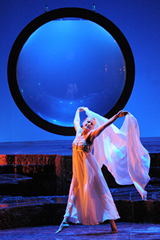| Opera Reviews | 27 April 2024 |
| Salome
seduces in Bologna by Silvia Luraghi |
|
| R. Strauss: Salome Teatro Comunale di Bologna 16 January 2010 |
|
|
In spite of the current financial crisis which threatens opera companies in Italy, the Teatro Comunale continues to thrive having received a modest increase in the state's financial support, due to its good performance in productivity over past seasons. Quite unexpectedly trade union protests, frequent at opening nights, were not organized even though relations between the theater's workers and general manager Marco Tutino are anything but peaceful. However for once everybody was just enjoying the performance and the gala evening. The production, co-produced with Trieste's Teatro Verdi, was directed by Gabriele Lavia, with sets by Alessandro Camera and costumes by Andrea Viotti. The setting was rather simple, with contrasting colors (red for the rocks on the stage, arranged as large steps, white for the full moon on the background of a black sky), while singers wore early 20th century costumes. Prophet Jochanaan was lifted with chains dragging his arms from an underground prison to satisfy Salome's morbid curiosity. Salome's capricious childish attitude soon turned into perversion, reaching its climax in the dance. Inside Herodes' place, the full moon was replaced by a large magnifying mirror; behind it the Jews ended their discussion on the coming of the Messiah, then moved out to leave space for Salome's frenzied dance, which she ended completely naked. Soprano Erika Sunnegårdh, who substituted the expected Nadja Michael at relatively short notice, proved physically and theatrically perfect for the role, dancing in an extraordinary manner. The vocal side was perhaps not as outstanding; her top notes were ringing and in tune, but the lower register sounded empty and could not easily be heard, in spite of conductor Nicola Luisotti trying to keep the orchestra's volume as low as possible. Jochanaan was bass baritone Mark Doss, a veteran of the role, who proved to be correct and idiomatic without impressing greatly. Robert Brubaker was very appreciable as Herodes, both vocally and theatrically, but the same cannot be said for Dalia Schächter, a Herodias with some marked problems with voice control. The last scene was the least convincing: while Jochanaan's beheaded body is lifted from his jail by the ankles, a giant head emerges from the ground, with Salome confidently lying upon it in a much more quiet and reassuring manner than one would expect at this point of the opera. But apparently everybody liked everything as the audience cheered everyone and the night ended in a triumph. |
|
| Text ©
Silvia Luraghi Photo © Teatro Comunale DI Bologna |

 A
new production of Richard Strauss' Salome opened the 2010 season
at Bologna's Teatro Comunale.
A
new production of Richard Strauss' Salome opened the 2010 season
at Bologna's Teatro Comunale. 





